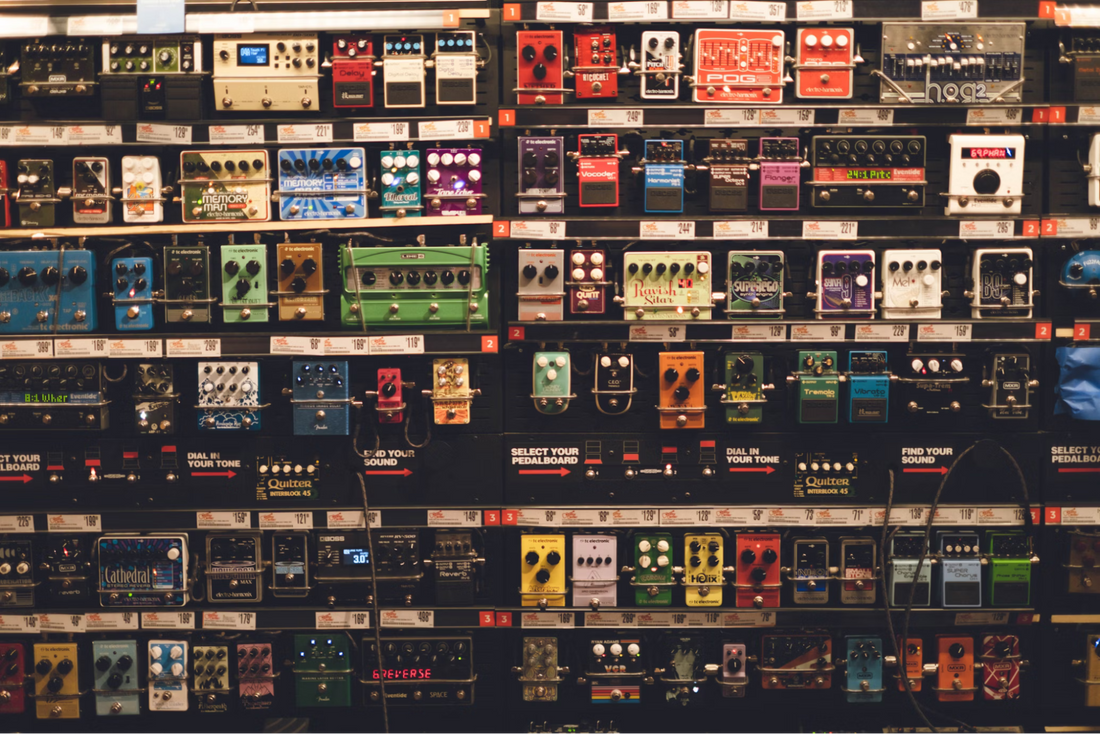Why You Need a Compressor Pedal in Your Setup
Compressor pedals are a mystery for a lot of guitar players. Admittedly, it's not the easiest or most obvious effect to hear in action, but once you understand its importance in shaping the sound, it won't leave your pedalboard.
To put it simply, compressors are used to shape the dynamic range of a sound. That is, it boosts the intensity of quieter notes and lowers loud peaks and transients to create a more consistent and smooth sound. When used right, it can take your tone to another level.
In this guide, we will demystify compressor pedals, explaining the effect's role in your sound and showcasing some of the best compressor units in 2025. Let's dive in!

How Does Compression Work?
Compression is an effect that's frequently used in the studio not only on guitars, but also on vocals, bass, drums, and any other instrument you can think of. Because oftentimes the effect is used subtly, it's not always easy to hear it in action, but once you do you'll realize its importance in music.
Let's first understand what dynamic range is: dynamic range refers to the difference between the quietest and loudest parts of an audio signal. Take a look at the image below:

This waveform represents an audio signal with a high dynamic range, meaning that it has both loud and quiet parts. Now, let's see what happens when we add compression:

Notice how the waveform on the right looks more even, with fewer variations in volume. That's compression in a nutshell. While it might be useful to visualize the effect, keep in mind that it's also important to listen to how it sonically affects your sound and how to dial it correctly.
In the video below from JHS pedals, you can hear the compression effect in action:
Common Parameters Found in Compressor Pedals
What Is the Difference Between Optical, VCA, and FET Compressors?
- Optical (OPTO) compressors use a light-sensitive element and offer smooth, natural compression.
- VCA compressors provide precise, fast, and transparent control over dynamics.
- FET compressors deliver a more aggressive, punchy sound with faster attack times.
While many parameters allow you to control compression, different compressor pedals will offer different controls. Some, like the Warm Audio Pedal76, offer a handful of knobs to meticulously adjust the effect, while others like the BMF Effects Little Red Compressor are quite simple, only featuring a Level and a Comp knob.
For that reason, it is important to consider how much control and fine-tuning possibilities you expect when choosing a compressor pedal. Sometimes less is more and a simple pedal will do the trick in evening out your tone, but you might prefer a more robust and larger option if you're a perfectionist.
Below, we explore seven compression pedals that will be an excellent next addition to your pedalboard if you're looking for a more even tone and explain the features and differences between them.

Best Compressor Pedals in 2025
Warm Audio Pedal76
Main Features
- 1176-style FET compressor
- Custom CineMag USA output transformer
- Ratio, attack, release, output, and input controls
- Input sensitivity control
- Ground lift
- DI output pad
- DI gain control
The Warm Audio Pedal76 is based on arguably the most famous and widely used compressor of all time: the 1176. This is a FET-style compressor, a unit controlled by a transistor that is capable of providing faster attack times and more precise compression if compared to its counterparts.
On this all-analog pedal, you will find five basic parameters that give you detailed control over how much compression you're applying to your signal. Another very useful feature of the Pedal76 is the VU meter, which lets you visually see how much gain reduction is being applied without having to rely solely on your ears.
On its back panel, the Pedal76 has three outputs that can be used for different applications and a few extra controls such as a ground lift and a DI output pad, meaning you can use the pedal not only with guitar and bass but also with a microphone for vocals.
Last but not least the Pedal76, just like any other 1176-style compressor, adds some analog character to audio signals that sound very pleasant to the ear, even when compression isn't engaged, making it one of the best-sounding units on the list.
BearFoot FX Putting Green
Main Features
- Optical compressor that mimics amp and speaker compression
- Built-in preamp
- Can be used as a lead booster
- Volume and compression knobs
- Active treble and bass control
The BearFoot FX Putting Green is a simple yet powerful optical compressor designed to be subtle. As optical-style compressors are known for their smooth and musical character, this unit can be an excellent choice if you're looking for a pedal that will even out your tone but won't sacrifice your dynamic range.
The compression section in the Putting Green is very simple, and the effect is controlled by a single knob labeled Comp. Turning up the knob will boost the signal going into the optical circuit, resulting in a more compressed tone.
Another interesting feature of the Putting Green is the built-in EQ, with active treble and bass control. Both knobs are very responsive and allow you to further shape your tone, even when compression is disengaged. The pedal sounds very good as a preamp and lead booster as well.
BMF Effects Little Red Compressor
Main Features
- Vintage Dyna-Comp style compressor
- Volume and sustain controls
- True bypass
One of the most minimalist pedals on our list, the BMF Effects Little Red Compressor is a faithful reproduction of the famous vintage Dyna-Comp style unit. Featuring only two knobs, it's a simple unit that can yield some great results when dialed-in right.
Just like the Dyna-Comp, the Little Red Compressor focuses on sustain, that is, making your notes ring out for longer to give you a fuller yet more controlled tone. The knobs are pretty responsible so you have a lot of range to work with.
Despite being an excellent pedal, the Little Red Compressor isn't as versatile as some other units on the list, as it doesn't feature controls for attack and release, for example. Still, we recommend it for any guitarists who are looking for a hassle-free solution to even out their guitar tone.
Mojo Hand FX Clarity Pedal
Main Features
- Clean, studio-like quality compressor
- Mix, comp, and level knobs
- Built-in silent noise gate
- Two types of compression (slope/envelope)
The Mojo Hand FX Clarity is a compressor pedal designed to sound as clear as possible and has a studio-like quality to it. Featuring two types of compression (slope/envelope) and a built-in silent noise gate, it's an easy-to-use unit that offers lots of tone possibilities.
With the middle switch, you can choose between slope and envelope: in slope mode, the unit has a linear traditional style of compression with fast attack and a smoother feel. In envelope mode, the Clarity compressor sounds punchier and heavier, giving more definition to the transients of your audio signal.
In both compressor modes, the comp knobs work like a charm, being very responsive to the changes you make. The Clarity also features a very useful built-in silent noise gate to not interfere with your signal. This pedal is an excellent choice if you're looking for a balance between ease of use and versatility.
EarthQuaker Devices The Warden V2
Main Features
- Studio-grade optical compressor
- High-grade components
- Six independent parameters
- True bypass
One of the most complete yet compact compressor pedals on our list, the EarthQuaker Devices Warden V2 features a studio-grade optical compression circuit and six independent parameters for detailed control over how your tone is compressed.
Apart from your usual attack, release, level, and ratio knobs, you will also find a sustain control, which lets you control how hot the signal coming to the unit is, allowing for quick changes on the intensity of the compression effect.
Another great feature of The Warden is the tone knob, a parameter designed to control the coloration given by the pedal to your sound. When turned counter-clockwise, it functions as a treble cut, while when turned clockwise it acts as a treble boost.
TC Electronic HyperGravity Compressor
Main Features
- Studio-quality multiband compressor
- TonePrint function
- Vintage mode
- Sustain, level, attack, and blend parameters
The TC Electronic HyperGravity is a digital studio-quality compressor with three distinct modes: Spectra, Vintage, and Toneprint. This versatile unit offers an excellent balance between compactness and number of features.
In Spectra mode, the pedal acts as a multiband compressor that sounds precise and tight, affecting each frequency band. When flipping the switch to Vintage mode, the HyperGravity gains a more warm and analog feel, paying homage to classic units of the past.
Finally, the TonePrint mode/function lets you control the compression parameters via the free app for smartphones or computers, giving you the power to refine each function more precisely.
BOSS CS-3 Compression Sustainer
Main Features
- Compact compressor/sustainer pedal
- Level, tone, attack, and sustain parameters
- Low-noise design
As with most BOSS pedals, the CS-3 Compression Sustainer is a very straightforward compressor pedal that is versatile and sounds good right out of the box, with four simple parameters to customize the effect.
This pedal has a very neutral compression circuit, meaning that, unlike the Warm Audio Pedal76, for example, it won't color your sound and will give you the most transparent results possible.
One particular scenario where the CS-3 performs really well is when giving more sustain to an otherwise dry and weak audio signal, and this function sounds pretty good when paired with everything from distortion to modulation and time-based effect pedals.
Frequently Asked Questions
Why Should I Use a Compressor Pedal?
Compressor pedals can even out the dynamics in your tone and help you give out a much more balanced and studio-like performance, making louder sounds quieter and quieter sounds louder. The effect works really well when paired with other pedals, and once you put one in our setup, you'll likely keep it engaged most of the time.
Can a Compressor Pedal Work With Both Electric and Acoustic Guitar and Bass?
Yes, most compressor pedals sound good on the electric guitar, acoustic guitar, bass, and any instrument you can think of, as the same compression concept is applied universally. However, there are some pedals dedicated exclusively to certain instruments.
Where Do I Place a Compressor Pedal in My Signal Chain?
Compressor pedals are typically placed early in the signal chain, right after the guitar output or before overdrive/distortion pedals, to maintain dynamic control. However, you can experiment with putting your compressor pedal in different positions on your pedalboard to achieve different tones.

Conclusion
Compressor pedals are an essential addition to any pedalboard. Adding one to your setup will surely help you achieve a more consistent and smooth tone both in the studio and in live concerts. When choosing the perfect compressor pedal for you, make sure to consider features such as the type of compression, and parameters.
We hope this article was helpful in demystifying the compressor effect! Below is a recap of all the pedals mentioned in the article.
|
Pedal |
Price |
|
$269.00 |
|
|
$179.00 |
|
|
$219.00 |
|
|
$139.00 |
|
|
$199.00 |
|
|
May Vary |
|
|
May Vary |
You can check these and many other pedals in our store!
More Interesting Reads:
Modulation Pedals Explained: A Guide to Finding the Perfect Effects Unit
Overdrive, Distortion, and Fuzz Pedals | Understanding the Differences
Essential Guitar Pedals for Beginners | What Pedals Should I Buy First?
Bonus: Use the code IASN10 at checkout for an extra 10% discount!








